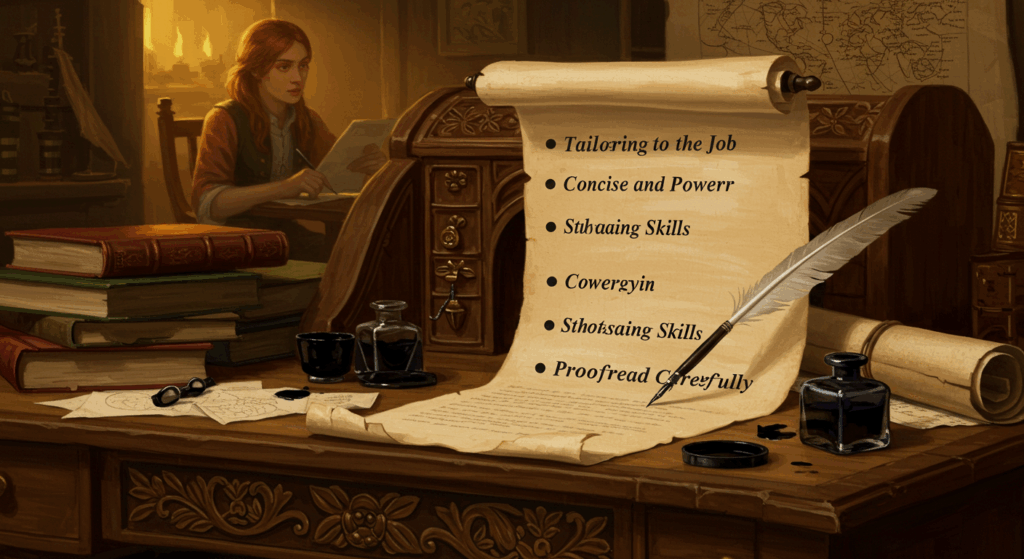Let’s talk about Cover Letter vs CV. You know that moment when a job app asks for a cover letter and a CV, and your brain goes, “Wait… aren’t they kinda the same?” Totally fair. They do hang out together a lot—like Netflix and snacks—but they’re not twins. They’re more like that power duo in a heist movie: one handles the planning, the other does the talking.
In this guide, I’m walking you through a no-nonsense, low-anxiety comparison of a cover letter vs CV—what each one is, the purpose of both, clear examples, and how to use them together so you’re not just applying… you’re actually getting interviews (and, ya know, paid). I’ll keep it casual, drop in some mini jokes, and add a few human imperfections, because ngl, polished-to-death advice can feel robotic. Cool? Cool.
Quick vibe check: What are we even talking about?
Before we go into a full comparison, let’s define the players:
- CV (Curriculum Vitae): A structured document listing your experience, skills, education, achievements, and more. It’s usually 1–2 pages in many countries (UK/EU/Aus use “CV” where Americans say “resume”). In the U.S./Canada, CV means a longer academic doc (multi-page) used for research/teaching roles. Annoying? A bit. But we can handle it.
- Cover Letter: A short, friendly(ish) letter (¾–1 page) where you explain why you want this job, why you fit, and how your past wins connect to their needs. It’s basically your pitch deck but in words. It’s not a repeat of your CV—it’s the narration.
TL;DR: Your CV is the data; your cover letter is the story. Yin and yang. Peanut butter and jelly. Spotify and… noise-canceling headphones.
Cover Letter vs CV: A simple comparison
| Feature | CV | Cover Letter |
|---|---|---|
| Core purpose | Present your career facts and proof (skills, results, dates). | Persuade with narrative: why you, why now, why this team. |
| Length | 1–2 pages (general). US academic CVs: multi-page. | ¾–1 page. Keep it tight. |
| Tone | Objective, scannable, bullet-heavy. | Conversational, tailored, employer-focused. |
| Structure | Sections: Summary, Skills, Experience, Education, Projects, etc. | 3–4 short paragraphs: Hook → Fit → Proof → Close. |
| ATS impact | Heavily scanned by ATS; keyword alignment matters. | Often read by humans first; supports the case your CV makes. |
| Customization | Moderate (job-specific keywords + reordered bullets). | High (company name, role, exact business problems). |
| When required | Almost always. | Sometimes optional, but powerful if done well. |
Why this comparison even matters
Because if you treat a cover letter like a CV (or vice versa), you’ll either bore the recruiter or miss your chance to connect. Both have a purpose—and when you combine them well, you look thoughtful, prepared, and honestly just… easy to hire.
The purpose of each (and how they work together)
1. The purpose of a CV
- Show you’re qualified at a glance.
- Provide measurable proof (numbers, outcomes, timelines).
- Make it simple to validate your claims (titles, companies, dates).
2. The purpose of a cover letter
- Connect the dots between your past and their future.
- Show you’ve researched them (lightly! not stalker-vibes).
- Demonstrate communication skills and genuine motivation.
- Fill context gaps: career shifts, travel breaks, short stints, etc.
Think of it like this: if your CV is your LinkedIn “About + Experience,” your cover letter is the DM you send the hiring manager that makes them actually click your profile.
Context check: CV vs Resume (because global hiring is… chaotic)
- US/Canada: “Resume” = the 1–2-page document you siubmit for most roles. “CV” = for academic/medical/research roles (longer, exhaustive).
- UK/EU/Australia/Asia (often): “CV” is used where Americans say “resume.” It’s still 1–2 pages, targeted for the role.
If a posting says “CV” but it’s a corporate job (marketing, product, ops), deliver a classic resume-style CV (1–2 pages). If it’s a U.S. university or research role, they want the long academic CV (publications, grants, conference talks, teaching, etc.). Or, If you’re unsure… read the posting. Then tailor.
When to send what: quick scenarios (with friendly examples)
- Corporate role (marketing analyst, product manager, ops lead):
Send a 1–2 page CV/resume + a cover letter that connects your projects to their KPIs (traffic growth, CAC, LTV, churn, time-to-ship, whatever). - Creative role (designer, copywriter, video editor):
CV + cover letter + portfolio. Your letter should explain your creative taste and process, linking to specific pieces (“Rebrand for X boosted CTR by 28%—I can do similar for your holiday campaign.”) - Tech role (frontend dev, data engineer):
CV + cover letter (brief but targeted) + GitHub/Case Study links. Use the letter to highlight problem-solving and business impact, not just stacks. (I get it, you love TypeScript; same.) - Academic role:
Academic CV (long) + cover letter that highlights research agenda, teaching philosophy, and grants. - Early career / career switch:
CV + cover letter—the letter is your place to show transferable skills and “why me” energy.
Anatomy of a strong CV (with mini examples)
Must-have sections (for most non-academic roles)
- Header: Name, city, email, phone, LinkedIn/portfolio.
- Summary (2–3 lines): A quick snapshot of what you do and what problems you solve.
Example: “Marketing analyst with 3 years turning messy funnels into clear growth levers; built dashboards that cut monthly reporting time by 60%.” - Skills (targeted): Tools + capabilities (e.g., SQL, GA4, A/B testing, stakeholder comms).
- Experience: Reverse chronological; bullets with impact metrics.
- Education/Certs: Keep it neat.
- Projects (optional but clutch): Especially good for juniors or switchers.
Bullet formula (please steal this)
Action verb + task/context + metric/result + business impact.
Examples:
- “Launched onboarding experiments that cut time-to-value by 28%, raising week-2 retention from 42% → 54%.”
- “Rebuilt ETL pipelines (dbt + BigQuery), reducing dashboard latency from 12m to 40s; stakeholder NPS +2.1.”
Design & formatting tips (ATS-friendly)
- Use simple headings and standard section names.
- Avoid fancy tables/columns that might confuse parsers.
- Keep font readable (10.5–12pt).
- Save as PDF (unless the posting requests Word).
- File name:
Firstname-Lastname-Role-2025.pdf. Easy for recruiters to find later.
Anatomy of a strong cover letter (with examples you can adapt)
Your cover letter is 3–4 short paragraphs. Think skimmable, not essay.
1. Paragraph 1: The hook (your “why us”)
- Show you did light research.
- Give one credible reason you care.
Example:
“Hey [Team/Name]—when I saw you’re rolling out a marketplace for indie sellers, I kinda lit up. I spent the last year helping a similar platform reduce seller churn by 19%, and I’d love to bring that playbook over.”
2. Paragraph 2: The fit (2–3 wins they’ll care about)
- Mirror their job description language.
- Use examples with numbers.
Example:
“At FigmaFriends, I led the email lifecycle revamp: segmented onbording flows + triggers that lifted activation 31%. Paired with a referral push, we hit 18% MoM growth without extra ad spend.”
3. Paragraph 3: The bridge (how you’ll help next)
- Connect your track record to their roadmap.
Example:
“You’re expanding to SEA; I’ve shipped localized campaigns in ID/PH with MAUs +24% in one quarter. I can stand up scrappy testing fast—then help document the keepers so the team scales clean.”
Close: The human sign-off
- Invite a chat. Keep it warm, not thirsty.
Example:
“If it’s helpful, I can share dashboards/workflows I’d start with in the first 30 days. Either way, cheering for your launch—seems like a fun rocketship.”
Pro-tip: personalize one detail per company (a product update, customer segment, or strategy note). It signals effort without writing a novel.
Side-by-side: the purpose and vibe difference
- CV: “Here are my receipts.”
- Cover Letter: “Here’s why these receipts matter to you.”
- CV: “I improved X by Y%.”
- Cover Letter: “Given your push into B2B, I’d apply that same approach to onboarding and expansion.”
- CV: Data.
- Cover Letter: Story. (But still include numbers—stories love receipts.)
Real talk: Do hiring managers read cover letters?
Some do, some don’t. But the ones who do are often the ones making the decision, and a good letter can bump you from “maybe” to “call them.” Also: when a posting says “optional,” think of that as “secret advantage.” If time’s tight, write a tight one (200–300 words). A small, sharp letter beats a long, rambly one every time (same rule for texts after 2am, honestly).
Common mistakes (and how to fix them)
- Repeating your CV
- Fix: Pick 2–3 examples to expand with context. New info, not copy-paste.
- One-size-fits-all letter
- Fix: Add one company-specific sentence in paragraph one and one role-specific win in paragraph two.
- Vague wins
- Fix: Numbers, please. If you can’t share exacts, use ranges (“~20%,” “low six figures,” “2x”).
- Passive voice & buzzword salad
- Fix: Write like you talk at work. “Shipped,” “built,” “led,” “debugged,” “drove.”
- Formatting chaos
- Fix: Simple fonts, logical spacing, no decorative borders. You’re not making a carnival poster (unless you are, then send me a ticket).
- Wrong file names
- Fix:
First-Last-CV-Role.pdfandFirst-Last-Cover-Letter-Role.pdf.
- Fix:
- Typos in names (company, hiring manager)
- Fix: Double-check. Then check again. Then command-Z your chaos.
The art of tailoring (without spending 3 hours per app)
Here’s a 15-minute workflow that actually works:
- Skim the job post (2–3 minutes)
- Capture 5–7 keywords: tools, outcomes, responsibilities.
- Tune your CV (5 minutes)
- Reorder bullets so the top 2 match the posting’s top needs.
- Swap in the posting’s exact phrasing (but don’t go wild).
- Write your cover letter (6–8 minutes)
- Paragraph 1: one sentence about them (product, market, goal).
- Paragraph 2: 2–3 quick wins that map to those needs (examples with numbers).
- Paragraph 3: how you’d apply it next month if hired.
- Ship it
- PDF unless they say otherwise.
- Check that links work (portfolio, GitHub, LinkedIn). Nothing like sending a 404 with your hopes and dreams attached.
ATS stuff (not scary, promise)
- CV: Use standard section headers (“Experience,” “Education,” “Skills”). Avoid text boxes and fancy layouts. Include role keywords naturally in bullets.
- Cover letter: Not always parsed by ATS, but keep it clean. Include the role title and a couple of the main skills/keywords—naturally, not like you’re stuffing a turkey.
Examples of keyword-smart (but human) bullets:
- “Built Looker dashboards for growth, finance, and ops; trimmed reporting time 60% and improved forecast accuracy 12%.”
- “Led cross-functional sprint (PM + Eng + Design) to ship waitlist flow; activation rate up 18%.”
Formatting details nobody tells you but matter
- Margins: ~0.5–1 inch.
- Font: Inter, Calibri, Arial, or similar. Clean > quirky.
- Dates: Use consistent format (e.g., “May 2023 – Aug 2025”).
- Links: Hyperlink text (e.g., “Portfolio”) instead of pasting long URLs.
- Consistency: If you bold role titles in one job, do it everywhere. Recruiters love symmetry (and coffee).
Micro-templates you can copy (lightly)
CV summary examples
- “Customer-obsessed product manager shipping zero-to-one features that unlock retention and revenue; curious, collaborative, and allergic to fluff.”
- “Data analyst who turns spaghetti spreadsheets into decision-grade dashboards; saved ~20 hrs/reporting cycle and boosted accuracy 12%.”
CV bullet examples
- “Owned lifecycle email + in-app nudges; improved day-7 retention 22% and reduced support tickets 18%.”
- “Refactored React components; bundle size −35%, LCP −420ms, leading to +7% checkout conversion.”
Cover letter opener examples
- “Your mission to make budgeting feel less like a dentist appointment? Say less. I spent 2 years making personal finance UX… not boring.”
- “Saw your Q2 deck about expanding into EDU; I launched campus partnerships at my last company that drove 11k signups in 90 days.”
Special track: academic CV vs industry CV
- Academic CV includes: publications (with citations), conferences, teaching, grants/funding, service, research interests, affiliations. Often 5–15 pages over time.
- Industry CV/resume: condense to 1–2 pages, highlight measurable outcomes, tools, product/market context. The purpose is speed and clarity for hiring teams.
If you’re crossing over from academia to industry, use your cover letter to translate research rigor into business outcomes (project management, stakeholder comms, data storytelling).
FAQ (because your group chat asked)
Q: Can I skip the cover letter if it’s optional?
A: You can. But a good one gives you a comparison edge, especially if your CV has a non-traditional path or you’re slightly under-qualified on paper.
Q: One page or two for the CV?
A: Early-mid career: 1 page is lovely; 2 pages is fine if you’ve got real substance. Don’t pad.
Q: Do I need a different CV for every job?
A: Not from scratch. Keep a master CV; adjust bullets and ordering for each role. 5–10 minutes of tailoring beats blasting out 50 generic apps.
Q: Should my cover letter be formal?
A: Professional, yes. Stiff, no. Sound like a capable human someone would want on the team.
Q: What if I have gaps?
A: Own them. “Took 6 months to care for family / travel / upskill in data viz—returned with X course completed and Y project shipped.” The letter is perfect for this.
Putting it all together: a tiny playbook
- Read the job post and highlight the top 5 outcomes they care about.
- Tailor your CV so the first bullets in your last 1–2 roles speak to those outcomes. Add metrics.
- Write a cover letter with 3 paragraphs: hook (them), wins (examples), bridge (how you’ll help).
- Check formatting + filenames.
- Send, track, follow up in 5–7 days if you haven’t heard back (short, kind note; no “circling back for the third time at 11:59pm,” please).
A quick comparison recap (because we love a checklist)
- Cover Letter – purpose: persuade with context, show fit, spark a human “yes.”
- CV – purpose: present evidence cleanly so hiring teams can verify you quickly.
- Cover Letter – examples: 3 paragraphs, 2–3 quantified wins, company-specific sentence.
- CV – examples: action-oriented bullets with metrics and business impact.
- Together: story + proof = momentum.
Final friendly nudge (aka the wrap-up)
If you remember nothing else, remember this: your CV proves you can do the job; your cover letter proves you should. Use both to make the recruiter’s life easier—clear, tailored, and just human enough that they wanna meet you.
You’ve got this. Open that doc, write the first sentence (even if it’s messy), and polish for 15 minutes. Then hit send. Future-you (the one with a nicer coffee budget) is already saying thanks. Now go—draft that cover letter, tweak that CV, and apply to three roles today. ✨









